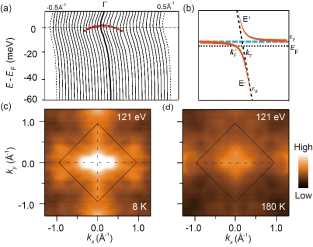Band dependent interlayer f-electron hybridization in CeRhIn5
A key issue in heavy fermion research is how subtle changes in the hybridization between the 4f (5f) and conduction electrons can result in fundamentally different ground states. CeRhIn5 stands out as a particularly notable example: when replacing Rh with either Co or Ir, antiferromagnetism gives way to superconductivity.

(a) The energy distribution curves along ΓM, divided by the Fermi-Dirac distribution, (b) Schematic diagram of the hybridization process, (c, d) Photoemission intensity maps at 8 K(c) and 180 K(d).
In this photoemission study of CeRhIn5, Prof. Feng Donglai group demonstrates that the use of resonant angle-resolved photoemission spectroscopy with polarized light allows to extract detailed information on the 4f crystal field states and details on the 4f and conduction electron hybridization, which together determine the ground state. They directly observe weakly dispersive Kondo resonances of f electrons and identify two of the three Ce 4f15/2 crystal-electric-field levels and band-dependent hybridization, which signals that the hybridization occurs primarily between the Ce 4f states in the CeIn3 layer and two more three-dimensional bands composed of the Rh 4d and In 5p orbitals in the RhIn2 layer. The results lead to connecting the properties observed at elevated temperatures with the unusual low-temperature properties of this enigmatic heavy fermion compound. (Phys.Rev.Lett. 2018, 120, 066403)
Back

